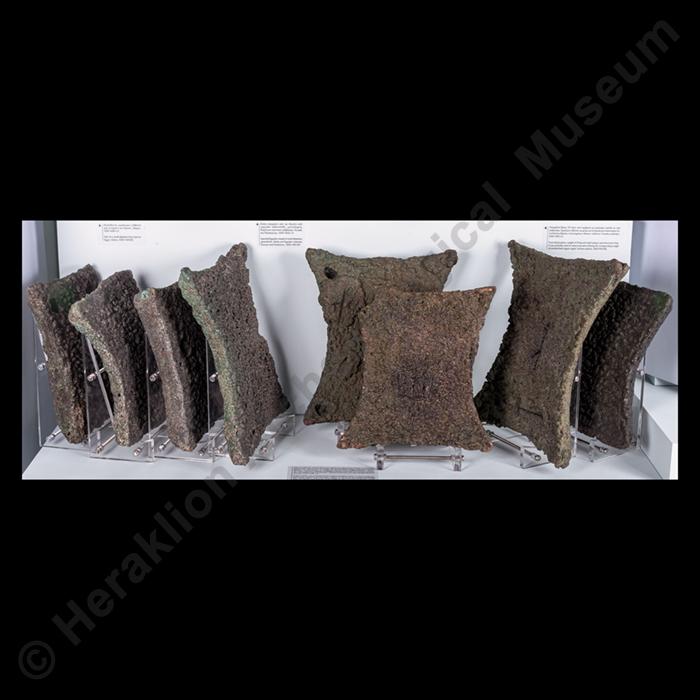Copper ingot
Χ721
Metal (Copper)
Intact
Length: 45 cm.Width: 39 cm.
Hagia Triada
Royal Villa
Late Bronze Age. Neopalatial period, Late Minoan IB period.:
1500 - 1450 BC:
Gallery:
VCase:
50Exhibition thematic unit:
Late Bronze Age - Neopalatial period (1700-1450 BC). The New Palaces. The zenith of Minoan civilisationTrade and foreign contacts
Description
Oxhide copper ingot cast in a rectangular slab with concave sides and protruding corners, a shape that resembles the stretched hide of an ox. This standardised shape is how copper was transported as a commodity, with each ingot weighing around 30 kilos. During the New Palace period, Crete systematically imported copper from other regions, since there are no copper deposits on the island. Although oxhide ingots have been found at many Neopalatial sites, the largest number so far come from the Royal Villa of Agia Triada, where 19 copper ingots were stored, stacked in rows, in Room 7 of the villa. The signs incised on the surface of some ingots are probably connected to the copper trade. The lead isotope analysis of ingots of the Neopalatial period has shown that the raw material comes from Cyprus and another area, as yet undetermined.Bibliography:
Halbherr, F., E. Stefani and L. Banti. "Hagia Triada nel Periodo Tardo Palaziale." ASAtene (1977): 7-342. Kanta, Α. "Επισκόπηση των Σχέσεων μεταξύ Κρήτης, Αιγαίου και Εγγύς Ανατολής στην Εποχή του Χαλκού." In Ν. Chr. Stampolidis and Α. Karetsou (eds), Ανατολική Μεσόγειος. Κύπρος - Δωδεκάνησα - Κρήτη. 16ος - 6ος αι. π.Χ., Heraklion, 1998, 30-52. Stos-Gale, Z.A. "Biscuits with Ears": A search for the origin of the Eerliest oxhide ingots." In P.P. Betancourt and S.C. Ferrence (eds), Metalurgy: Understanding How, Learning Why. Prehistory Monographs 29. Philadelphia, 2011, 221-229.Author:
E. S.Photographs' metadata
